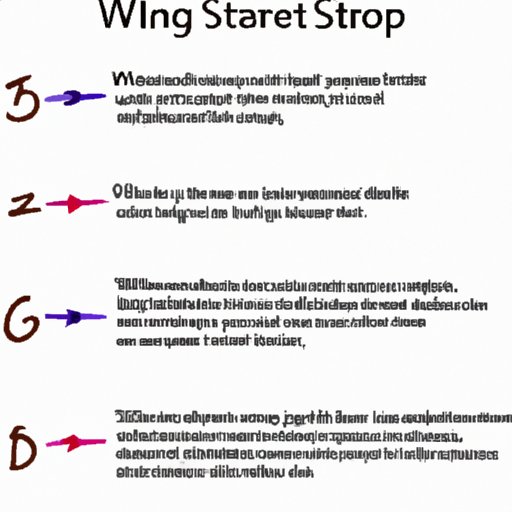Introduction
The writing process is a series of steps taken to produce a well-written piece of work. It includes brainstorming, researching, outlining, drafting, revising, editing, and publishing. It is an essential part of any writing project and can help make the final product much more effective and efficient. Writing is an art form, and the process of perfecting it can take time and practice. In this article, we will explore what the writing process looks like step-by-step and provide tips on how to make it easier.

Outlining the Steps of the Writing Process
The writing process consists of seven major steps. Here is a brief overview of each one:
Step 1: Brainstorming
Brainstorming is the first step in the writing process. It involves generating ideas and topics for your writing project. It’s important to do this before you start researching or writing so that you have a clear direction for your project.
Step 2: Research
Once you have an idea of what you’re going to write about, it’s time to do some research. This involves finding reliable sources of information and gathering data to support your topic. Research should always be done with a critical eye, as not all sources are created equal.
Step 3: Outlining
The next step is to create an outline. An outline helps organize your thoughts and ensure that your paper has a logical flow. It also helps you stay on track while writing and prevents you from getting lost or sidetracked.
Step 4: Drafting
The fourth step in the writing process is drafting. This is when you actually put pen to paper (or fingers to keyboard) and begin writing your paper. The goal here is to get your ideas down on paper without worrying too much about grammar and spelling.
Step 5: Revising
After you have a draft of your paper, it’s time to revise. This involves reading through your paper and making changes to make the content clearer and more concise. It also involves checking for errors in grammar, spelling, and punctuation.
Step 6: Editing
Editing is the sixth step in the writing process. This is when you check your paper for errors in grammar, spelling, and punctuation. It also involves making sure that your paper follows the correct formatting guidelines and that all sources are properly cited.
Step 7: Publishing
The last step in the writing process is publishing. This can involve submitting your paper to a journal or website, printing it out, or posting it online. It is important to remember that once you publish your work, it is out there for the world to see, so be sure to proofread and edit it carefully beforehand.
A Step-by-Step Guide to the Writing Process
Now that you have an understanding of the steps involved in the writing process, let’s look at each step in more detail. Here is a step-by-step guide to help you understand the writing process better:
Step 1: Brainstorming
Brainstorming is the first step in the writing process. It involves generating ideas and topics for your writing project. It’s important to do this before you start researching or writing so that you have a clear direction for your project. Brainstorming can be done in many different ways, such as listing possible topics, mind mapping, or free writing. Try different methods to find the one that works best for you.
Step 2: Research
Once you have an idea of what you’re going to write about, it’s time to do some research. This involves finding reliable sources of information and gathering data to support your topic. Research should always be done with a critical eye, as not all sources are created equal. When researching, be sure to use reputable sources and cite them correctly.
Step 3: Outlining
The third step in the writing process is creating an outline. An outline helps organize your thoughts and ensure that your paper has a logical flow. It also helps you stay on track while writing and prevents you from getting lost or sidetracked. Outlining is a great way to make sure that all of your ideas are connected and that your paper flows logically from one point to the next.
Step 4: Drafting
The fourth step in the writing process is drafting. This is when you actually put pen to paper (or fingers to keyboard) and begin writing your paper. The goal here is to get your ideas down on paper without worrying too much about grammar and spelling. Don’t worry if your first draft isn’t perfect; that’s why you have the other steps in the writing process.
Step 5: Revising
After you have a draft of your paper, it’s time to revise. This involves reading through your paper and making changes to make the content clearer and more concise. It also involves checking for errors in grammar, spelling, and punctuation. If you find any mistakes, make sure to fix them before moving on to the next step.
Step 6: Editing
Editing is the sixth step in the writing process. This is when you check your paper for errors in grammar, spelling, and punctuation. It also involves making sure that your paper follows the correct formatting guidelines and that all sources are properly cited. This is an important step, as it ensures that your paper is professional and polished.
Step 7: Publishing
The last step in the writing process is publishing. This can involve submitting your paper to a journal or website, printing it out, or posting it online. It is important to remember that once you publish your work, it is out there for the world to see, so be sure to proofread and edit it carefully beforehand.
How to Master the Writing Process in 5 Easy Steps
Writing can be intimidating, but it doesn’t have to be. Here are five easy steps to help you master the writing process:
Step 1: Set Goals
Setting goals is an important first step in the writing process. Take some time to think about what you want to accomplish with your writing project. Are you trying to inform, persuade, or entertain? What do you want your readers to take away from your work? Having clear goals in mind will help you stay focused and motivated throughout the writing process.
Step 2: Develop a Schedule
Creating a schedule is key to staying on track with your writing project. Break your project into smaller tasks and set deadlines for each one. This will help you stay organized and ensure that you don’t fall behind. It is also important to give yourself breaks throughout the writing process so that you don’t get overwhelmed or burned out.
Step 3: Break Down the Process
Breaking down the writing process into smaller parts can make it less overwhelming. Think of it as a journey with multiple stops along the way. Each step in the process is just one step closer to completing your project. Taking it one step at a time will help you stay focused and motivated.
Step 4: Get Feedback
Getting feedback from others is an important part of the writing process. Ask friends, family members, or colleagues to read your work and give you constructive criticism. This will help you identify any weak points in your writing and make improvements where necessary.
Step 5: Practice, Practice, Practice
Finally, the best way to master the writing process is to practice. Writing is a skill, and the more you do it, the better you will become. So don’t be afraid to experiment and try new things. Keep writing and keep improving!
Breaking Down the Writing Process into Bite-Sized Pieces
The writing process can seem daunting, but it doesn’t have to be. Breaking it down into smaller, more manageable pieces can make it easier to tackle. Here are some tips for breaking down the writing process into bite-sized pieces:
Breaking Down the Steps
Start by breaking down the writing process into individual steps. This will help you understand each step better and make it less overwhelming. Once you know what each step entails, it will be easier to focus on one thing at a time.
Working on One Piece at a Time
When tackling large projects, it can be helpful to break them down into smaller, more manageable pieces. Working on one piece at a time will help you stay focused and prevent you from feeling overwhelmed. Plus, it’s much easier to make progress when you’re only focusing on one task at a time.
Scheduling Writing Time
It’s important to set aside dedicated time for writing. This will help you stay disciplined and motivated throughout the writing process. Scheduling specific times for writing will also help you stay on track and ensure that you don’t get sidetracked.

The Writing Process: What You Need to Know
Writing can be a daunting task. But with the right knowledge and tools, it can be much easier. Here are some things to keep in mind when embarking on the writing process:
Being Prepared
It’s important to be prepared before starting the writing process. Take some time to brainstorm ideas, research your topic, and create an outline. This will help you stay organized and focused throughout the process.
Understanding Your Audience
Understanding who your audience is and what they expect from your writing is essential. Doing research on your audience will help you tailor your writing to their needs and interests.
Knowing Your Subject Matter
Having a good understanding of your subject matter is key to producing quality work. Make sure you have a thorough understanding of the topic before you start writing.
Using the Right Tools
Using the right tools can make the writing process much easier. There are many helpful tools available, such as grammar and spell checkers, writing templates, and citation generators. Knowing which tools to use and when can be a huge help.
Taking Breaks
Writing can be stressful, so it’s important to take breaks. Taking regular breaks will help you stay focused and energized throughout the writing process. It’s also important to take breaks to avoid burnout.
Conclusion
The writing process can be daunting, but it doesn’t have to be. By breaking it down into smaller steps, using the right tools, and taking breaks, you can make the process much easier. Remember to set goals, develop a schedule, and get feedback from others. With practice, you can master the writing process and produce quality work.
(Note: Is this article not meeting your expectations? Do you have knowledge or insights to share? Unlock new opportunities and expand your reach by joining our authors team. Click Registration to join us and share your expertise with our readers.)
